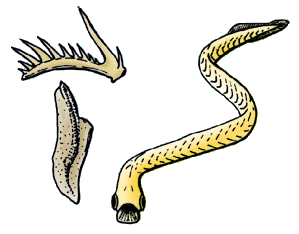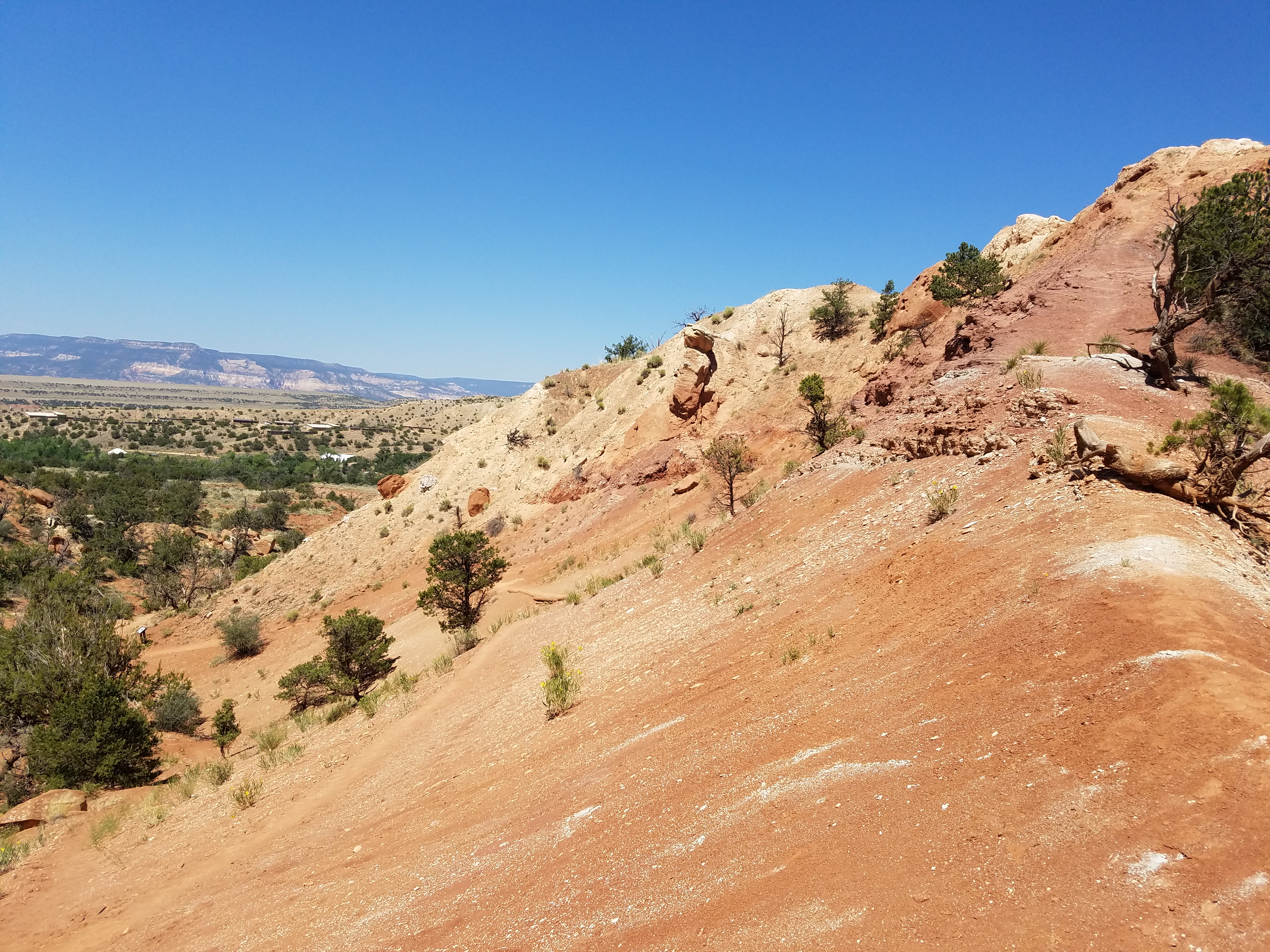|
Upper Triassic
The Late Triassic is the third and final epoch of the Triassic Period in the geologic time scale, spanning the time between Ma and Ma (million years ago). It is preceded by the Middle Triassic Epoch and followed by the Early Jurassic Epoch. The corresponding series of rock beds is known as the Upper Triassic. The Late Triassic is divided into the Carnian, Norian and Rhaetian ages. Many of the first dinosaurs evolved during the Late Triassic, including '' Plateosaurus'', ''Coelophysis'', '' Herrerasaurus'', and '' Eoraptor''. The Triassic–Jurassic extinction event began during this epoch and is one of the five major mass extinction events of the Earth. Etymology The Triassic was named in 1834 by Friedrich von Alberti, after a succession of three distinct rock layers (Greek meaning 'triad') that are widespread in southern Germany: the lower Buntsandstein (colourful sandstone'')'', the middle Muschelkalk (shell-bearing limestone) and the upper Keuper (coloured clay). The ... [...More Info...] [...Related Items...] OR: [Wikipedia] [Google] [Baidu] |
International Commission On Stratigraphy
The International Commission on Stratigraphy (ICS), sometimes unofficially referred to as the International Stratigraphic Commission, is a daughter or major subcommittee grade scientific organization that concerns itself with stratigraphy, stratigraphical, geology, geological, and chronology, geochronological matters, worldwide. It is the largest subordinate body of the International Union of Geological Sciences (IUGS). The ICS is essentially a permanent working committee, working subcommittee, which meets far more regularly than the quadrennial meetings scheduled by the IUGS, when it meets as a congress or committee, membership of the whole. Aims One of its main aims, a project begun in 1974, is to establish a multidisciplinary standard and global geologic time scale that will ease paleontology, paleontological and geobiology, geobiological comparisons region to region by benchmarks with stringent and rigorous strata criteria called Global Boundary Stratotype Section and Points ... [...More Info...] [...Related Items...] OR: [Wikipedia] [Google] [Baidu] |
Series (stratigraphy)
Series are subdivisions of rock layers based on the age of the rock and formally defined by international conventions of the geological timescale. A series is therefore a sequence of strata defining a chronostratigraphic unit. Series are subdivisions of systems and are themselves divided into stages. Series is a term defining a unit of rock layers formed during a certain interval of time (a chronostratigraphic unit); it is equivalent (but not synonymous) to the term ''geological epoch'' (see epoch criteria) which defines the interval of time itself, although the two words are sometimes confused in informal literature. Series in the geological timescale The geological timescale has all systems in the Phanerozoic eonothem subdivided into series. Some of these have their own names; in other cases a system is simply divided into a Lower, Middle and Upper series, with official series being capitalized and unofficial designations (such as "middle Cretaceous") being left uncapital ... [...More Info...] [...Related Items...] OR: [Wikipedia] [Google] [Baidu] |
Buntsandstein
The Buntsandstein (German for ''coloured'' or ''colourful sandstone'') or Bunter sandstone is a lithostratigraphy, lithostratigraphic and allostratigraphy, allostratigraphic unit (a sequence of rock strata) in the Subsurface (geology), subsurface of large parts of west and central Europe. The Buntsandstein predominantly consists of sandstone layers of the Lower Triassic series (stratigraphy), series and is one of three characteristic Triassic units, together with the Muschelkalk and Keuper that form the Germanic Trias Supergroup (geology), Supergroup. The Buntsandstein is similar in age, sedimentary facies, facies and lithology with the Bunter (geology), Bunter of the British Isles. It is normally lying on top of the Permian Zechstein and below the Muschelkalk. In the past the name Buntsandstein was in Europe also used in a chronostratigraphy, chronostratigraphic sense, as a subdivision of the Triassic system. Among reasons to abandon this use was the discovery that its base lies ... [...More Info...] [...Related Items...] OR: [Wikipedia] [Google] [Baidu] |
Germany
Germany, officially the Federal Republic of Germany, is a country in Central Europe. It lies between the Baltic Sea and the North Sea to the north and the Alps to the south. Its sixteen States of Germany, constituent states have a total population of over 84 million in an area of , making it the most populous member state of the European Union. It borders Denmark to the north, Poland and the Czech Republic to the east, Austria and Switzerland to the south, and France, Luxembourg, Belgium, and the Netherlands to the west. The Capital of Germany, nation's capital and List of cities in Germany by population, most populous city is Berlin and its main financial centre is Frankfurt; the largest urban area is the Ruhr. Settlement in the territory of modern Germany began in the Lower Paleolithic, with various tribes inhabiting it from the Neolithic onward, chiefly the Celts. Various Germanic peoples, Germanic tribes have inhabited the northern parts of modern Germany since classical ... [...More Info...] [...Related Items...] OR: [Wikipedia] [Google] [Baidu] |
Friedrich August Von Namoh
Friedrich may refer to: Names *Friedrich (given name), people with the given name ''Friedrich'' *Friedrich (surname), people with the surname ''Friedrich'' Other *Friedrich (board game), a board game about Frederick the Great and the Seven Years' War * ''Friedrich'' (novel), a novel about anti-semitism written by Hans Peter Richter *Friedrich Air Conditioning, a company manufacturing air conditioning and purifying products *, a German cargo ship in service 1941-45 See also *Friedrichs (other) *Frederick (other) *Nikolaus Friedreich Nikolaus Friedreich (1 July 1825 in Würzburg – 6 July 1882 in Heidelberg) was a German pathologist and neurologist, and a third generation physician in the Friedreich family. His father was psychiatrist Johann Baptist Friedreich (1796–18 ... {{disambig ja:フリードリヒ ... [...More Info...] [...Related Items...] OR: [Wikipedia] [Google] [Baidu] |
Triassic–Jurassic Extinction Event
The Triassic–Jurassic (Tr-J) extinction event (TJME), often called the end-Triassic extinction, marks the boundary between the Triassic and Jurassic periods, . It represents one of five major extinction events during the Phanerozoic, profoundly affecting life on land and in the oceans. In the seas, about 23–34% of marine genus, genera disappeared; Coral, corals, Bivalvia, bivalves, Brachiopod, brachiopods, Bryozoa, bryozoans, and Radiolaria, radiolarians suffered severe losses of diversity and Conodont, conodonts were completely wiped out, while marine vertebrates, Gastropoda, gastropods, and benthic foraminifera were relatively unaffected. On land, all Archosauromorpha, archosauromorph reptiles other than Crocodylomorpha, crocodylomorphs, dinosaurs, and pterosaurs became extinct. Crocodylomorphs, dinosaurs, pterosaurs, and mammals were left largely untouched, allowing them to become the dominant land animals for the next 135 million years. Plants were likewise significantly a ... [...More Info...] [...Related Items...] OR: [Wikipedia] [Google] [Baidu] |
Eoraptor
''Eoraptor'' () is a genus of small, lightly built, Basal (phylogenetics), basal sauropodomorpha, sauropodomorph dinosaur. One of the earliest-known dinosaurs and one of the earliest sauropodomorphs, it lived approximately 231 to 228 million years ago, during the Late Triassic in Western Gondwana, in the region that is now northwestern Argentina. The type species, type and only species, ''Eoraptor lunensis'', was first described in 1993, and is known from an almost complete and well-preserved skeleton and several fragmentary ones. ''Eoraptor'' had heterodont, multiple tooth shapes, which suggests that it was omnivore, omnivorous. History of discovery [...More Info...] [...Related Items...] OR: [Wikipedia] [Google] [Baidu] |
Herrerasaurus
''Herrerasaurus'' is likely a genus of saurischian dinosaur from the Late Triassic period. Measuring long and weighing around , this genus was one of the earliest dinosaurs from the fossil record. Its name means "Herrera's lizard", after the rancher who discovered the first specimen in 1958 in South America. All known fossils of this carnivore have been discovered in the Ischigualasto Formation of Carnian age (late Triassic according to the ICS, dated to 231.4 million years ago) in northwestern Argentina. The type species, ''Herrerasaurus ischigualastensis'', was described by Osvaldo Reig in 1963 and is the only species assigned to the genus. ''Ischisaurus'' and ''Frenguellisaurus'' are synonyms. For many years, the classification of ''Herrerasaurus'' was unclear because it was known from very fragmentary remains. It was hypothesized to be a basal theropod, a basal sauropodomorph, a basal saurischian, or not a dinosaur at all but another type of archosaur. However, with t ... [...More Info...] [...Related Items...] OR: [Wikipedia] [Google] [Baidu] |
Coelophysis
''Coelophysis'' ( Traditional English pronunciation of Latin, traditionally; or , as heard more commonly in recent decades) is a genus of coelophysid Theropoda, theropod dinosaur that lived Approximation, approximately 215 to 201.4 million years ago during the Late Triassic Period (geology), period from the middle Norian to Rhaetian age in what is now the southwestern United States. ''Megapnosaurus'' was once considered to be a species within this genus, but this interpretation has been challenged and the genus ''Megapnosaurus'' is now considered valid. ''Coelophysis'' was a small, slenderly built, ground-dwelling, bipedal carnivore that could grow up to long. It is one of the earliest known dinosaur genera. Scattered material representing similar animals has been found worldwide in some Late Triassic and Early Jurassic formations. The type species ''C. bauri'', originally given to the genus ''Coelurus'' by Edward Drinker Cope in 1887, was described by the latter in 1889. T ... [...More Info...] [...Related Items...] OR: [Wikipedia] [Google] [Baidu] |
Plateosaurus
''Plateosaurus'' (probably meaning "broad lizard", often mistranslated as "flat lizard") is a genus of plateosaurid dinosaur that lived during the Late Triassic period, around 214 to 204 million years ago, in what is now Central and Northern Europe. ''Plateosaurus'' is a basal (early) sauropodomorph dinosaur, a so-called "prosauropod". The type species is ''Plateosaurus trossingensis''; before 2019, that honor was given to ''Plateosaurus engelhardti'', but it was ruled as undiagnostic (i.e. indistinguishable from other dinosaurs) by the ICZN. Currently, there are three valid species; in addition to ''P. trossingensis'', ''P. longiceps'' and ''P. gracilis'' are also known. However, others have been assigned in the past, and there is no broad consensus on the species taxonomy of plateosaurid dinosaurs. Similarly, there are a plethora of synonyms (invalid duplicate names) at the genus level. Discovered in 1834 by Johann Friedrich Engelhardt and described three years later by Her ... [...More Info...] [...Related Items...] OR: [Wikipedia] [Google] [Baidu] |
Dinosaur
Dinosaurs are a diverse group of reptiles of the clade Dinosauria. They first appeared during the Triassic Geological period, period, between 243 and 233.23 million years ago (mya), although the exact origin and timing of the #Evolutionary history, evolution of dinosaurs is a subject of active research. They became the dominant terrestrial vertebrates after the Triassic–Jurassic extinction event 201.3 mya and their dominance continued throughout the Jurassic and Cretaceous periods. The fossil record shows that birds are feathered dinosaurs, Evolution of birds, having evolved from earlier Theropoda, theropods during the Late Jurassic epoch, and are the only dinosaur lineage known to have survived the Cretaceous–Paleogene extinction event approximately 66 mya. Dinosaurs can therefore be divided into avian dinosaurs—birds—and the extinct non-avian dinosaurs, which are all dinosaurs other than birds. Dinosaurs are varied from taxonomy (biology), taxonomic, ... [...More Info...] [...Related Items...] OR: [Wikipedia] [Google] [Baidu] |
Geologic Time Scale
The geologic time scale or geological time scale (GTS) is a representation of time based on the rock record of Earth. It is a system of chronological dating that uses chronostratigraphy (the process of relating strata to time) and geochronology (a scientific branch of geology that aims to determine the age of rocks). It is used primarily by Earth scientists (including geologists, paleontologists, geophysicists, geochemists, and paleoclimatologists) to describe the timing and relationships of events in geologic history. The time scale has been developed through the study of rock layers and the observation of their relationships and identifying features such as lithologies, paleomagnetic properties, and fossils. The definition of standardised international units of geological time is the responsibility of the International Commission on Stratigraphy (ICS), a constituent body of the International Union of Geological Sciences (IUGS), whose primary objective is to preci ... [...More Info...] [...Related Items...] OR: [Wikipedia] [Google] [Baidu] |







